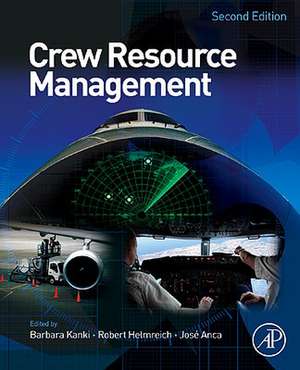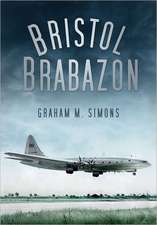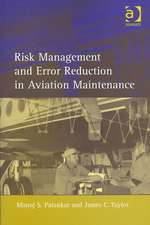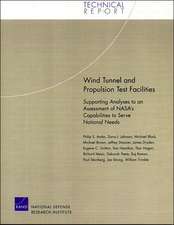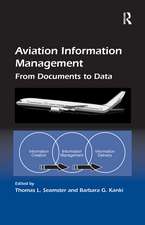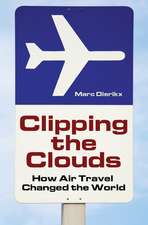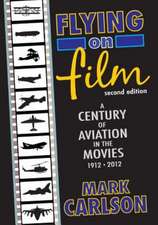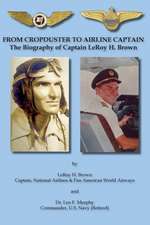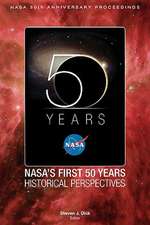Crew Resource Management
Editat de Barbara G. Kanki, José Anca, Robert L. Helmreichen Limba Engleză Paperback – 26 mar 2010
Cockpit Resource Management (CRM) has gained increased attention from the airline industry in recent years due to the growing number of accidents and near misses in airline traffic. This book, authored by the first generation of CRM experts, is the first comprehensive work on CRM. Cockpit Resource Management is a far-reaching discussion of crew coordination, communication, and resources from both within and without the cockpit. A valuable resource for commercialand military airline training curriculum, the book is also a valuable reference for business professionals who are interested in effective communication among interactive personnel.
Fifteen years later, CRM concepts have endured by not only integrating themselves into the fabric of training, but also expanding the team concept, evolving into new applications, and possibly most important to the original operators, inspiring development and integration of CRM into safety and quality assurance goals at the corporate level. A variety of CRM models have been successfully adapted to different types of industries and organizations, all based on the same basic concepts and principles. It has been adopted by the fire service to help improve situational awareness on the fireground. The new edition of Crew Resource Management continues to focus on CRM in the cockpit, but also emphasizes that the concepts and training applications provide generic guidance and lessons learned for a wide variety of 'crews' in the aviation system as well as in the complex and high-risk operations of many non-aviation settings.
Long considered the ?bible? in this field, much of the basic style and structure of CRM 1e will be retained in the new edition. Textbooks are often heavily supplemented with or replaced entirely by course packs in advanced courses in the aviation field, as it is essential to provide students with cutting edge information from academic researchers, government agencies (FAA), pilot associations, and technology (Boeing, ALION). Our edited textbook will offer ideal coverage with first hand information from each of these perspectives. Case examples, which are particularly important given the dangers inherent in real world aviation scenarios, are liberally supplied. An image collection and testbank will be offered, making us the only text on the market with ancillary support
Material from the first edition remains relevant today and will be fully updated, often by new authors now at the fore of the field. New material - to the tune of an additional 50% - will focuses on the challenges facing aviation specialists today. New topics will include: international and cultural aspects of CRM, design and implementation of Line-Oriented Flight Training (LOFT), airline applications beyond the cockpit, spaceflight resource management, non-aviation applications, AQP, LOSA and special issues pertaining to low-cost airline carriers.
The second edition editors offer essential breath of experience in aviation human factors from multiple perspectives (academia, government, and private enterprise) and the proposed contributors have all been chosen as experts in their fields who represent the diversity of the research of activities and organisational experience of CRM.
The only CRM text on the market offering an up-to-date synthesis of primary source material
*Instructors benefit from being able to adopt a single text for their courses, saves them time taken up by putting together course packs
New edition thoroughly updated and revised to include major new findings, complete with discussion of the int'l/cultural aspects of CRM, the design and implementation of LOFT
*Gives students and aviation professionals a firm foundation in both the extant research and current issues
Instructor web site with testbank and image collection
*The only text offering ancillary support
Liberal use of case examples
*Ensures that readers will know how to respond to dangers and implement solutions when placed in real-world situations where timing is of the essence
Preț: 506.92 lei
Preț vechi: 702.25 lei
-28% Nou
97.00€ • 103.73$ • 80.88£
Carte tipărită la comandă
Livrare economică 10-24 aprilie
Specificații
ISBN-10: 0123749468
Pagini: 536
Dimensiuni: 191 x 235 x 28 mm
Greutate: 0.89 kg
Ediția:2. Auflage.
Editura: Elsevier
Public țintă
Primary:Graduate students in aviation training, aviation psychology and human factors courses; aviation professionals in government, private, commercial and military settings (flight training, CRM facilitators, selection and recruitment specialists, instructor pilots, accident investigators, safety pilots, ATC personnel, aircraft engineers); aviation researchers.
Secondary:
Reference librarians at schools with human factors or aviation/aeronautical programs; trainers, managers and safety/quality personnel in other high-risk industries (emergency medicine, fire-fighters).
Cuprins
Forward John K. Lauber
Preface Barbara G. Kanki, Robert L. Helmreich and Joey Anca
Part I: The Nature of CRM 1. Why CRM? Empirical and Theoretical Bases of Human Factors - Robert L. Helmreich 2. Teamwork and Organizational Factors - Frank J. Tullo 3. Crews: Their Formation and their Leadership - Robert C. Ginnett 4. Communication - Barbara G. Kanki 5. Decision Making - Judith Orasanu 6. CRM (Non-Technical) Skills - Applications
Part II: CRM Training Applications 7. The Design, Delivery and Evaluation of Crew Resource Management Training - Eduardo Salas, Marissa L. Suffler and Luiz F. Xavier 8. Line Oriented Flight Training (LOFT): The intersection of technical and human factor Crew Resource Management (CRM) team skills - William R. Hamman 9. Line Operational Simulation Development Tools - Florian Jentsch and Mike Curtis 10. Crew Resource Management (CRM) and Line Operations Safety Audit (LOSA) - Bruce A. Tesmer 11. CRM: Spaceflight Resource Management - David C. Rogers 12. The Migration of Crew Resource Management Training - Brent Hayward and Andrew R. Lowe
Part III: CRM Perspectives 13. Regulatory Perspective - Kathy H. Abbott 14. Regulatory Perspective II - Doug Farrow 15. Integrating CRM into an Airline’s Culture: The Air Canada Process - Norman Dowd 16. The Accident Investigator’s Perspective - Katherine A. Lemos 17. The Airelines Perspective: Effectively Applying Crew Resource Management Principles in Today’s Aviation Environment - Don Gunther 18. Airline Perspective: Non US - Joey Anca 19. The Military Perspective - Paul O’Connor, Robert G. Hahn and Robert Nullmeyer
Part IV: Conclusions 20. Airline Pilot Training Today and Tomorrow - Linda M. Orlady 21. The Future of CRM - Barbara G. Kanki, Robert L. Helmreich and Joey Anca
Notă biografică
Earl L. Wiener is a professor of management science and industrial engineering at the University of Miami. He received his B.A. in psychology from Duke University and his Ph.D. in psychology and industrial engineering from Ohio State University. He served as a pilot in the U.S. Air Force and U.S. Army and is rated in fixed-wing and rotary-wing aircraft. He has conducted research in the areas of human vigilance, automobile and aviation safety, and accidents occurring to the elderly. Since 1979 he has been active in the aeronautics and cockpit automation research of NASA's Ames Research Center. Dr. Wiener is a fellow of the Human Factors Society and the American Psychological Association. Barbara G. Kanki is currently a staff research psychologist in the Aerospace Human Factors Research Division of NASA-Ames Research Center and a principal investigator in the Crew Factors research group. Dr. Kanki received her graduate degree from the Behavioral Sciences Department at the University of Chicago, where she specialized in the areas of communication and group dynamics. She came to Ames Research Center in 1985 as a National Research Council post-doctoral associate and began work in the aeronautical doman by studying the relationship between crew communication and aircrew performance, using both full-mission simulation and field research methods. Although much of the Crew Factors research focuses on the study of aircrew team performance and training in air transport operations, the work generalizes to other domains in the aviation system, such as aircraft maintenance, as well as to ground-based space operations. As such, the program has grown to include payload and orbiter processing teams for NASA shuttle missions and other teams, such as aquanauts and mountaineering teams, whose work environments are analogous to space operations in critical respects. Robert L. Helmreich is professor of psychology at the University of Texas at Austin. He received his Ph.D. in personality and social psychology from Yale University in 1966. He has conducted research on group processes and performance sponsored by NASA, the Office of Naval Research, and the FAA, as well as research on personality and motivation sponsored by the National Science Foundation and the National Institute of Mental Health. He is a fellow of the American Psychological Association and the American Psychological Society and former editor of the Journal of Personality and Social Psychology. He was chair of an FAA working group to develop the National Plan for Aviation Human Factors. He is a member of the National Academy of Sciences Committee on Space Biology and Medicine and Committee on Human Factors. He is Director of the NASA/University of Texas/FAA Aerospace Crew Performance Project investigating issues in crew selection, training, and performance evaluation in both aviation and space environments.
Descriere
Crew (or Cockpit) Resource Management training originated from a NASA workshop in 1979 that focused on improving air safety. The NASA research at that time found the primary cause of the majority of aviation accidents to be human error, and further showed the main problems to be failures of interpersonal communication, leadership, and decision making in the cockpit. By the time of publication of our first editon of CRM, was celebrated as the convergence of a concept, an attitude and a very practical approach to pilot training. Equally important was the convergence and enthusiastic support of the research community, aviation regulators, transport operators and the pilot unions. CRM was maturing, implementing and developing all at the same time.
Cockpit Resource Management (CRM) has gained increased attention from the airline industry in recent years due to the growing number of accidents and near misses in airline traffic. This book, authored by the first generation of CRM experts, is the first comprehensive work on CRM. Cockpit Resource Management is a far-reaching discussion of crew coordination, communication, and resources from both within and without the cockpit. A valuable resource for commercialand military airline training curriculum, the book is also a valuable reference for business professionals who are interested in effective communication among interactive personnel.
Fifteen years later, CRM concepts have endured by not only integrating themselves into the fabric of training, but also expanding the team concept, evolving into new applications, and possibly most important to the original operators, inspiring development and integration of CRM into safety and quality assurance goals at the corporate level. A variety of CRM models have been successfully adapted to different types of industries and organizations, all based on the same basic concepts and principles. It has been adopted by the fire service to help improve situational awareness on the fireground. The new edition of Crew Resource Management continues to focus on CRM in the cockpit, but also emphasizes that the concepts and training applications provide generic guidance and lessons learned for a wide variety of 'crews' in the aviation system as well as in the complex and high-risk operations of many non-aviation settings.
Long considered the ?bible? in this field, much of the basic style and structure of CRM 1e will be retained in the new edition. Textbooks are often heavily supplemented with or replaced entirely by course packs in advanced courses in the aviation field, as it is essential to provide students with cutting edge information from academic researchers, government agencies (FAA), pilot associations, and technology (Boeing, ALION). Our edited textbook will offer ideal coverage with first hand information from each of these perspectives. Case examples, which are particularly important given the dangers inherent in real world aviation scenarios, are liberally supplied. An image collection and testbank will be offered, making us the only text on the market with ancillary support
Material from the first edition remains relevant today and will be fully updated, often by new authors now at the fore of the field. New material - to the tune of an additional 50% - will focuses on the challenges facing aviation specialists today. New topics will include: international and cultural aspects of CRM, design and implementation of Line-Oriented Flight Training (LOFT), airline applications beyond the cockpit, spaceflight resource management, non-aviation applications, AQP, LOSA and special issues pertaining to low-cost airline carriers.
The second edition editors offer essential breath of experience in aviation human factors from multiple perspectives (academia, government, and private enterprise) and the proposed contributors have all been chosen as experts in their fields who represent the diversity of the research of activities and organisational experience of CRM.
The only CRM text on the market offering an up-to-date synthesis of primary source material
*Instructors benefit from being able to adopt a single text for their courses, saves them time taken up by putting together course packs
New edition thoroughly updated and revised to include major new findings, complete with discussion of the int'l/cultural aspects of CRM, the design and implementation of LOFT
*Gives students and aviation professionals a firm foundation in both the extant research and current issues
Instructor web site with testbank and image collection
*The only text offering ancillary support
Liberal use of case examples
*Ensures that readers will know how to respond to dangers and implement solutions when placed in real-world situations where timing is of the essence
